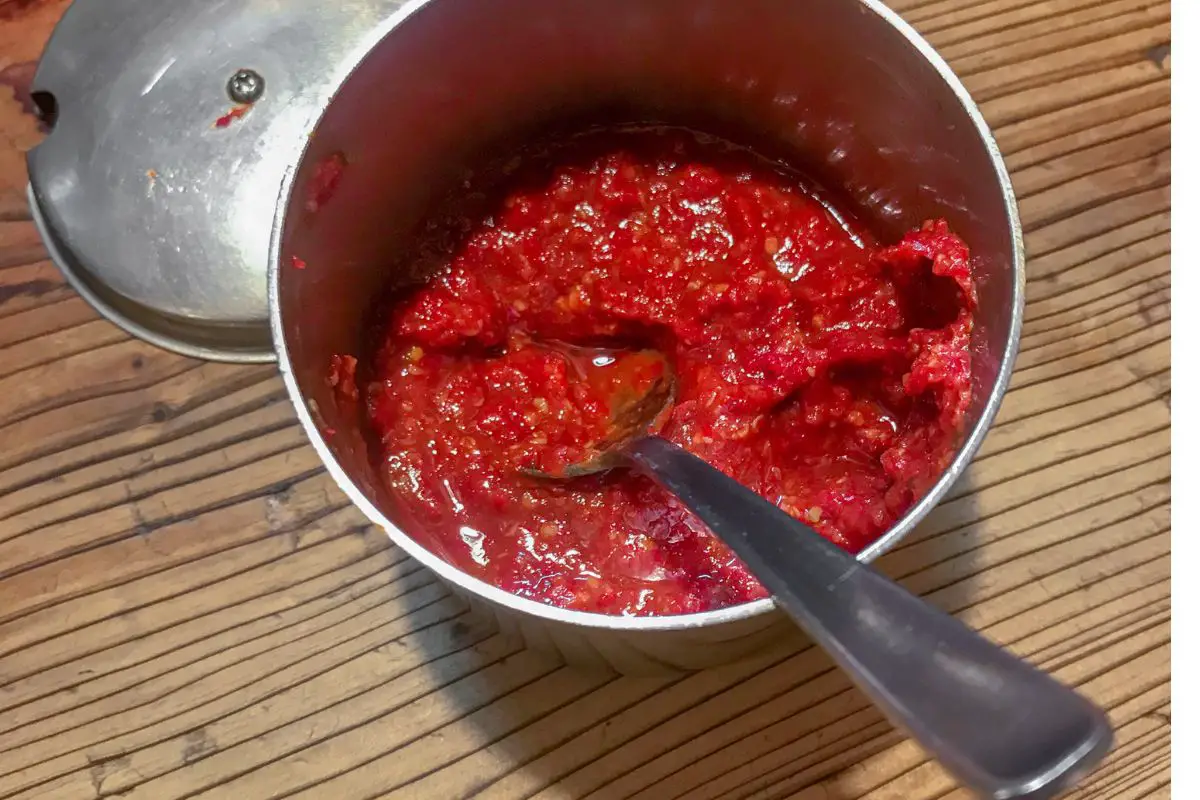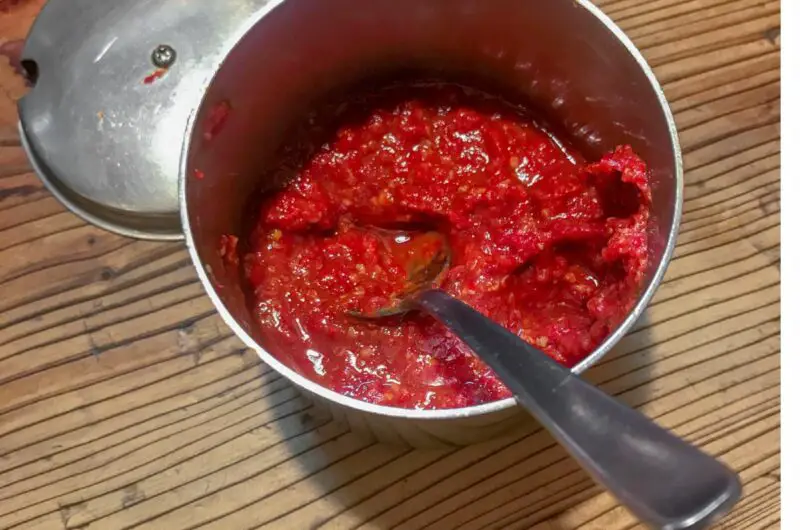If you have recently taken an interest in Asian cooking and cuisine, you are likely going to encounter a whole wealth of ingredients that are new to you.
Many of these ingredients may simply be hard to understand and equally may not be available in your local stores depending on where you live.
Doubanjiang is one of those ingredients, and if you have never had it before or can;t recall its flavor, it may be a bit harder to understand what is a good substitute for it, or what the flavor is actually trying to bring to a dish.
With an understanding of what this ingredient actually is, as well as its flavors are, we can better understand what works as a substitute.
Keep reading below to find out what Doubanjiang is, what flavors it brings to a dish, as well as how you can easily substitute it. Find this, and more, below!

What Is Doubanjiang?
Doubanjiang is a fermented bean and chili paste. These types of pastes with the suffix jiang, are common in Asian cooking, specifically Chinese cooking.
In the case of Doubanjiang it is very commonly used and derived from Sichuan cuisine.
Many describe it as the ‘soul of Sichuan cooking’ and it appears in many famous Sichuan dishes such as Mapo tofu, huoguo, and Sichuan Chicken.
This can be an important distinction, while Sichuan Doubanjiang is spicy but also earthy, other regions of China have their own version of the sauce, such as Tuxiang, and Shuizhu, which are much less spicy.
This said, the main characteristics of doubanjiang come from its combination of fermented soybeans and chili.
The broad beans bring an earthy umami flavor similar to miso, both being fermented bean products, but the addition of chili in the DOubanjiang adds a spicy element and funkiness from the fermented nature of the sauce.
The sauce is fermented so we need to pay special attention to how it is stored. One reason you may not have doubanjiang is because your last batch went off, and if you do manage to buy some make sure you store it correctly.
As it is fermented, if you leave it at room temperature it is going to continue fermenting.
As a result we need to keep it in the fridge to be extra careful with it and make sure its flavors and fermentation stays at the level we purchased it at to be sure to keep it securely sealed.
How To Substitute Doubanjiang?
Doubanjiang is both spicy and earthy, so we want something that checks both of these boxes for us.
1. Red Miso
Red Miso is particularly earthy and may be from fermented soy beans, as a result it can bring a lot of the savory elements that Doubanjiang can.
Classic doubanjiang will generally be spicier, so if you are substituting doubanjiang with miso, try adding a little extra spice if you can handle it and it will create a similar flavor to doubanjiang.
White miso would also work but is generally a lot sweeter than red miso as well as doubanjiang.
2. Gochujang
Gochujang is a Korean fermented chili product, which does have elements of fermented soy in it, albeit not from a bean.
Gochujang is similar to Doubanjiang, but the former is Korean and the latter is Chinese meaning they will generally be different.
Gochujang does have a sweetness that isn;t in the doubanjiang, but we just have to account for this by not adding any more sugar or sweet products.
However, Gochujang does bring a lot of the same spicy flavors to a dish that Doubanjiang would.
Using Gochujang in combination with miso would pretty much have the same flavor that Doubanjiang would, albeit a little sweeter than the original.
3. Ssamjang
Ssamjang is another type of fermented paste or sauce that is very similar to Doubanjiang, although its origins are from Korean, not China. That said, Ssamjang is quite similar in its ingredients to Doubanjiang.
The fermented sauce is made from fermented soy beans, red chili paste, sesame oil, onion, garlic, scallions, and sometimes sugar.
So, as you can see, Ssamjang, while both earthy and spicy, will focus more on the earthy and savory aspects of the sauce than the more spicy Doubanjiang, but you could up the spice content of whatever you are making to match the spice that Doubanjiang would bring.
Ssam actually refers to ‘wrap’ and refers to how the sauce is commonly used on wrapped goods, which basically means dipping sauce.
4. Douchi (tochi)
Douchi refers to a fermented black bean sauce from China. It is made from a simple method of fermenting and salting black beans, like many fermented bean dishes in Asia.
Yet, this fermented sauce does not really taste as you would expect. The beans become soft and mostly semi dry like a paste.
The smell is quite sharp and pungent due to the fermentation of the beans, but the result is something spicy, salty, bitter and sweet.
Its complexity is similar to that of Doubanjiang, but as mentioned, we likely need to up the spice content of other elements in order for the effects of Doubanjiang to be recreated.
5. Western Beans And Chili
So, most of the substitutes we have mentioned are generally ones that you would find in an Asian grocery store, or the Asian aisle in your grocery store.
But, perhaps the issue is that you don’t have an Asian store near you, and your grocery store is out or just doesn;t have these kinds of exported goods.
This is common, but there are still swaps you can make with more western ingredients.
As we identified, doubanjiang is pretty much fermented bean and chili paste.
In theory, you could buy a chili and some beans, maybe black beans or soybeans, but go for any you can get. If you simply added chili and beans to whatever you are making you might get something pretty similar to doubanjiang.
The main thing we will be missing is the fermented, aged, element that doubanjiang has, the funky flavor.
You can likely add this in with some form of vinegar, which naturally has that pickley aged flavor, although you don’t want too much of it.
You could even quick pickle some garlic, chili and beans, in the same vinegar before cooking to create an aged product which is similar.
6. Chilli Garlic Sauce
Chili Garlic Sauce is a type of Chinese sauce that is common in the West and you should be able to find chili garlic sauce fairly easily. This kind of sauce is generally known as Chiu Chow in China, where it originated.
You either get it in a form where oil and garlic are added to oil and you get a saucy type of spicy, earthy, oil, that is similar to doubanjiang. The latter sauce is easy to make at home.
Alternately, you can find sauces that have combined chili and garlic into a paste or sauce, there are likely Westernized versions of this in most Western grocery stores.
Final Thoughts
What may be clear is that Doubanjiang has a unique flavor that may be quite hard to recreate without other asian ingredients.
As you can see, most of the substitutes can be pretty easy if you have a selection of other Asian sauces and pastes out there. Something like Korea’s Gochujang or Ssamjang can perhaps have the closest relationship to Doubanjiang.
Beyond this, most Western shops sell Miso these days, and if you can find red miso this, with added chili, can really be a good substitute.
In lieu of any Asian exported goods you may have to settle simply for an addition of beans and chili, which can be easily found as a sauce in most Western grocery stores.
The 6 Best Substitutes For Doubanjiang You Can Find In Your Grocery Store
Course: Sides4
servings30
minutes40
minutes300
kcalNew to Asian cooking? Ingredients like doubanjiang may not be easy to get. Here are some simple swaps to make if you can’t find it that should be very similar.
Directions
- Decide on what substitute you need
- Pick a substitute from the list above
- Read what you need to substitute with
- Create the recipe and enjoy
Recipe Video
https://www.youtube.com/watch?v=TooDsskNHxkVideo can’t be loaded because JavaScript is disabled: Best Gochujang on Amazon Ranked | SAUCED (https://www.youtube.com/watch?v=TooDsskNHxk)- What Exactly Do Chickpeas Taste Like? Is There A Distinct Flavor? - September 30, 2023
- Top 11 Low Carb Options at Sonic Drive-In for Keto Diet - September 30, 2023
- What Should You Serve Alongside Potato Salad? 8 Incredible Side Dishes - September 30, 2023











